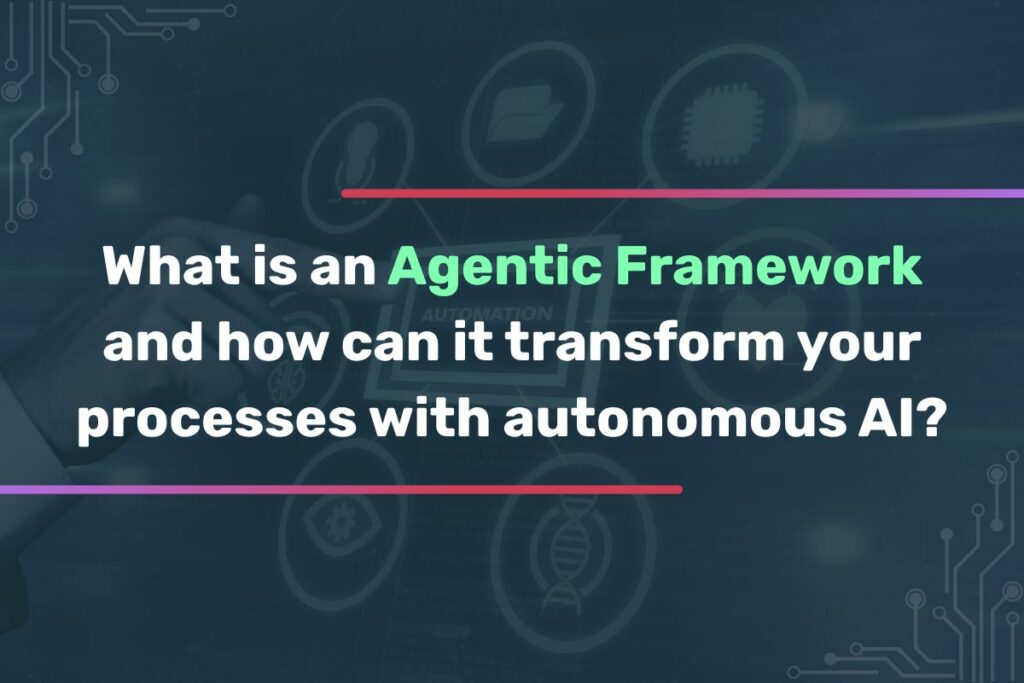
What is an Agentic Framework and how does it transform your processes with autonomous AI
The future of business automation is already here
In an increasingly dynamic and competitive business environment, traditional automation is no longer enough. Companies that aspire to lead their sector are adopting a new generation of artificial intelligence: Agentic Frameworks. These intelligent frameworks allow AI not only to execute tasks, but also to think, adapt, and orchestrate entire processes autonomously.
In this article, you will discover what an Agentic Framework is, how it works, and why it is one of the keys to digitally transforming your business with efficiency, scalability, and real intelligence.
👉 Result: greater operational efficiency, intelligent decisions, and real-time responsiveness.
Real use cases by sector
What is an Agentic Framework?
An Agentic Framework is an AI architecture composed of autonomous agents capable of making decisions, collaborating with each other, adapting to context, and managing end-to-end workflows. Unlike traditional automation systems, these agents:- Act autonomously, without constant human intervention.
- Collaborate with each other and with other systems to achieve objectives.
- Adapt in real time to changing data and environments.
- Orchestrate complete processes, from input to value delivery.
| Feature |
Traditional RPA |
Agentic Framework |
| Task |
Repetitive and fixed |
Adaptative and strategic |
| Autonomy | Low |
High |
| Decision-making |
Rule-based |
Goal- and context-based |
| Flexibility |
Limited |
Dynamic |
| Integration with AI |
Partial |
Native |
| Scalability |
Linear |
Composite and exponential |
How does it transform your business processes?
1. Intelligent orchestration of complete processes It’s no longer just about automating tasks. A single agent can respond to an email, but an Agentic Framework can autonomously manage complex processes such as credit applications, claims, or regulatory validation from start to finish. 2. Real-time decision-making With machine learning, NLP, or computer vision capabilities, agents analyze multiple data sources and respond at the right moment without the need for predefined rules. Example: in logistics, agents reassign routes based on traffic, weather, or vehicle status. 3. Reduction of costs and operating times Collaboration between agents eliminates human bottlenecks. The result? Up to 70% savings in processing times and dramatic improvements in accuracy. 4. Personalization at scale Agents learn from each user’s individual behavior, enabling personalized experiences without manual effort. Example: In retail, agents modify offers or recommendations in real time based on purchasing habits.Technology stack we work with at KSP
| Technology | Main application |
| LangChain | Agent orchestration with language models (LLM |
| AutoGen (Microsoft) | Task coordination between autonomous agents |
| CrewAI | Management of specialized AI teams |
| ReAct | Dynamic task planning with LLMs |
| Open Agents | Access to external tools by agents |
- Finance: autonomous credit validation in minutes, without human intervention.
- Industry: predictive maintenance with IoT sensors, historical data, and automatic orders.
- Customer service: classification, prioritization, and automatic resolution of complex incidents.
Is your company ready to adopt autonomous AI?
An Agentic Framework is not a fad: it is a structural advantage. Organizations that integrate it achieve: ✅ Scaling without increasing staff ✅ Optimizing operational accuracy ✅ Orchestrating processes with total visibility ✅ Reduce dependence on human errorHow does KSP help you build your own Agentic Framework??
At KSP, we design and integrate agentic systems tailored to your objectives:- 🔍 We assess your level of AI maturity
- 🧩 We identify the critical processes to be transformed
- 🏗️ We design scalable architectures
- 🚀 We train, deploy, and govern the system
- Traditional automation solves tasks.
- Agentic Frameworks solve processes.
